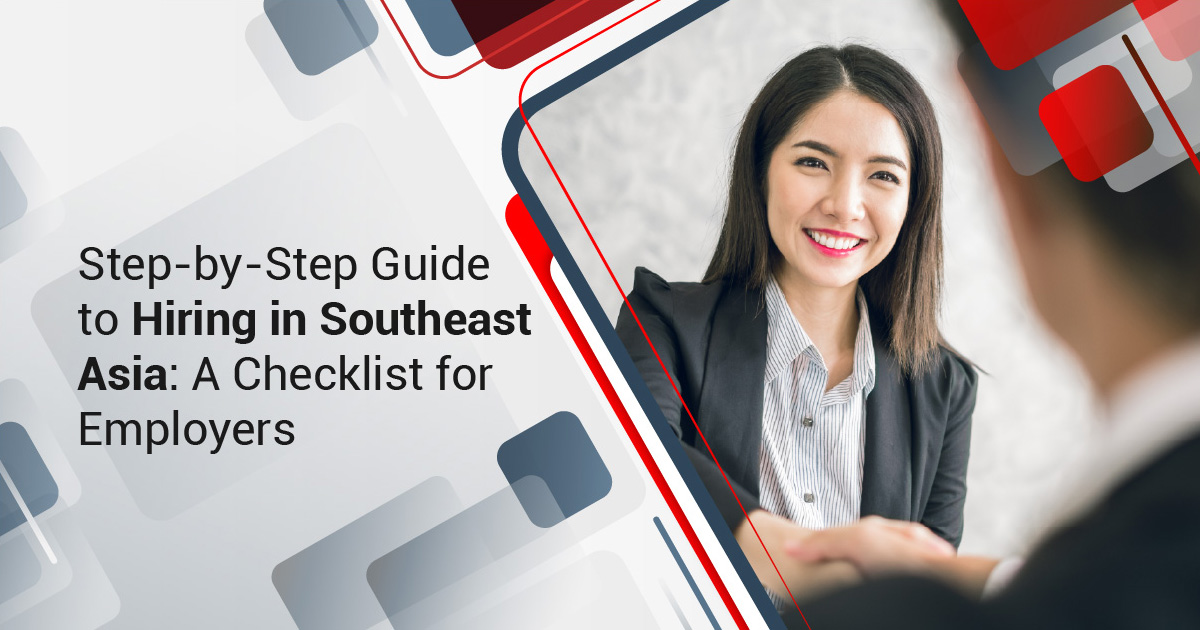Expanding your workforce into Asia unlocks access to a diverse and dynamic talent pool, driving innovation and growth. However, the region’s hiring landscape is a complex tapestry of varied labour laws, cultural norms, and economic environments. For employers, a strategic and informed approach is beneficial and essential for success.
This guide provides a comprehensive checklist to navigate the intricacies of hiring across Asia, ensuring a compliant and efficient process. It outlines the critical steps for building your team in Asia, from initial legal due diligence to successful onboarding. Following this roadmap will help you avoid common pitfalls and secure the top talent your business needs to thrive.
Related Read: Why Do Companies Choose to Outsource Hiring in 2025?
Key Takeaways
- Each country in Asia has unique employment regulations, including work pass requirements, statutory contributions, and compliance obligations. Researching these is essential to avoid legal pitfalls.
- Craft detailed job descriptions that outline responsibilities, required skills, and salary benchmarks to attract the right talent.
- Tailor your hiring approach to reflect local communication styles, workplace hierarchies, and cultural sensitivities for better candidate engagement.
- Use a mix of online job portals, employee referrals, and recruitment agencies to access a broader talent pool.
- Collaborate with a recruitment agency to navigate Asia’s complex hiring landscape efficiently and compliantly.
Pre-Hiring Checklist: Laying the Foundation

Before you post a single job opening, foundational work is required to ensure your hiring process is structured for success. Rushing this stage can lead to costly compliance issues and recruitment delays.
Understand Local Labour Laws and Regulations
Each country in Asia has its own distinct employment laws governing contracts, working hours, minimum wage, termination, and employee benefits.
- Compliance is Key: Research the specific legal requirements in your target country. For example, employers in Singapore must adhere to the strict requirements of the Employment Act.
- Work Pass Requirements: For foreign talent, understand the visa and work pass eligibility criteria, quotas, and application processes, which vary significantly from Singapore to Malaysia to Hong Kong.
- Statutory Contributions: Familiarise yourself with mandatory contributions like provident funds (e.g., CPF in Singapore, EPF in Malaysia) and social security schemes.
Define the Job Role and Candidate Profile
A clear and detailed job description is the cornerstone of effective recruitment.
- Specify Responsibilities: Outline the core duties, daily tasks, and long-term objectives for the role.
- Define Skill Requirements: List essential technical skills, qualifications, and years of experience. Also, consider “soft skills” like communication, problem-solving, and adaptability that align with your company culture.
- Set the Salary Benchmark: Research local salary benchmarks for similar roles to offer a competitive compensation package. Factor in bonuses, allowances, and other benefits customary in the target market.
Account for Cultural Nuances
Cultural intelligence is crucial when hiring in Asia. What works in one country may not resonate in another.
- Communication Styles: Be aware of different communication norms. For instance, direct communication styles common in Western cultures may contrast with the more indirect, high-context communication prevalent in countries like Japan or Thailand.
- Workplace Hierarchies: Understand the local perception of workplace hierarchy and management styles. This influences everything from interview etiquette to team integration.
- Localise Your Approach: Tailor your job advertisements and interview questions to reflect cultural sensitivities and local business practices.
Sourcing and Screening Checklist: Finding the Right Talent

With your foundation in place, the next phase is to actively find and screen potential candidates. A multi-channel sourcing strategy is often the most effective approach in Asia’s diverse markets.
Develop a Sourcing Strategy
Relying on a single platform is rarely sufficient. Diversify your channels to maximise your reach.
- Online Job Portals: Use both global platforms like LinkedIn and leading local job boards such as JobStreet in Southeast Asia, Ricebowl in Malaysia, and JobsDB in Hong Kong.
- Employee Referrals: Implement an employee referral program. Referrals often lead to high-quality candidates who are a good cultural fit.
- Leverage a Recruitment Agency: Partnering with a specialised recruitment agency provides immediate access to an extensive network of pre-screened, passive candidates who may not be active on job boards. An agency based in a regional hub like Singapore offers a unique advantage in understanding cross-border talent acquisition.
- Related Read: 5 Ways Manpower Staffing Services Streamline Your Hiring Process
Implement an Effective Screening Process
Efficiently screening a high volume of applications is critical to identifying top prospects quickly.
- Initial Screening: Review resumes against the core requirements outlined in your job description. Look for alignment in skills, experience, and career progression.
- Preliminary Interviews: Conduct brief phone or video calls to verify key qualifications, assess communication skills, and gauge the candidate’s genuine interest in the role.
- Technical and Skills Assessments: For technical roles, use standardised assessments or practical tests to validate a candidate’s proficiency.
Interview and Selection Checklist: Making the Right Hire
The interview stage is your opportunity to assess a candidate’s suitability beyond their resume. A structured and fair process is vital for making an informed decision.
Conduct Structured Interviews
A consistent interview process ensures all candidates are evaluated on the same criteria.
- Behavioural Questions: Use behavioural questions (e.g., “Tell me about a time you faced a challenge…”) to understand how a candidate has handled past work situations.
- Situational Questions: Pose hypothetical work scenarios to evaluate problem-solving abilities and decision-making skills.
- Involve Key Stakeholders: Include hiring managers and potential team members in the interview process to assess team fit and gain diverse perspectives.
Perform Due Diligence
Before extending an offer, verify the information provided by the candidate.
- Reference Checks: Contact professional references to gain insights into the candidate’s work ethic, performance, and interpersonal skills. Ensure you have the candidate’s consent before making contact.
- Background Checks: Depending on the role and industry, conduct background checks in compliance with local privacy laws. This may include verifying educational credentials and employment history.
Extend a Formal Job Offer
A clear and comprehensive offer letter prevents misunderstandings and sets the stage for a positive employment relationship.
- Include All Details: The offer should detail the job title, start date, salary, benefits, reporting structure, and any other relevant terms of employment.
- Provide a Formal Contract: The formal employment contract should be compliant with local labour laws and clearly outline the obligations of both the employer and the employee.
Onboarding and Integration Checklist: Ensuring Long-Term Success
Hiring is only half the battle. A structured onboarding process is crucial for integrating your new employee and setting them up for long-term success.
Prepare for Day One

Ensure everything is ready before the new hire arrives.
- Handle Paperwork: Complete all necessary employment documentation, including work pass issuance, tax forms, and benefits enrollment.
- Set Up Workspace and Tools: Prepare the employee’s physical or virtual workspace, including necessary hardware, software access, and email accounts.
Structure the Onboarding Programme
A well-designed onboarding program accelerates a new hire’s productivity and integration.
- Company and Culture Introduction: Provide an overview of the company’s mission, values, and culture. Introduce them to key team members and departments.
- Role-Specific Training: Clearly explain their role, responsibilities, and performance expectations. Provide access to necessary training materials and resources.
- Assign a Buddy or Mentor: Pair the new hire with an experienced team member to provide guidance and support during their initial months.
Partner With an Expert for Seamless Hiring in Asia
Navigating Asia’s recruitment landscape requires significant time, resources, and localised expertise, which makes outsourcing to a specialist an attractive option. At InCorp, a Singapore-based recruitment agency that covers a wide range of countries in the region, we are uniquely positioned to act as your strategic partner, offering a centralised gateway to the entire region.
By leveraging our established networks, deep understanding of cross-border compliance, and cultural insights, you can transform a complex process into a strategic advantage. We are capable of handling the intricacies of sourcing, screening, and navigating regulations, allowing you to focus on your core business while confidently building a high-performing team across Asia.
FAQs about Hiring in Southeast Asia
How do I ensure compliance with local labour laws when hiring across multiple countries in Asia?
- Research the specific legal requirements for each country where you plan to hire. Partnering with a recruitment agency or legal expert familiar with cross-border compliance can help you navigate these complexities.
What are the challenges of hiring foreign talent in Asia?
- Challenges include navigating work pass requirements, meeting salary thresholds, and adhering to quotas for foreign workers. Employers must also consider cultural integration and language barriers.
How can a recruitment agency help with hiring in Asia?
- A recruitment agency such as InCorp provides access to pre-screened candidates, ensures compliance with local regulations, and offers cultural insights. Agencies based in regional hubs like Singapore are particularly well-equipped to handle cross-border hiring.


